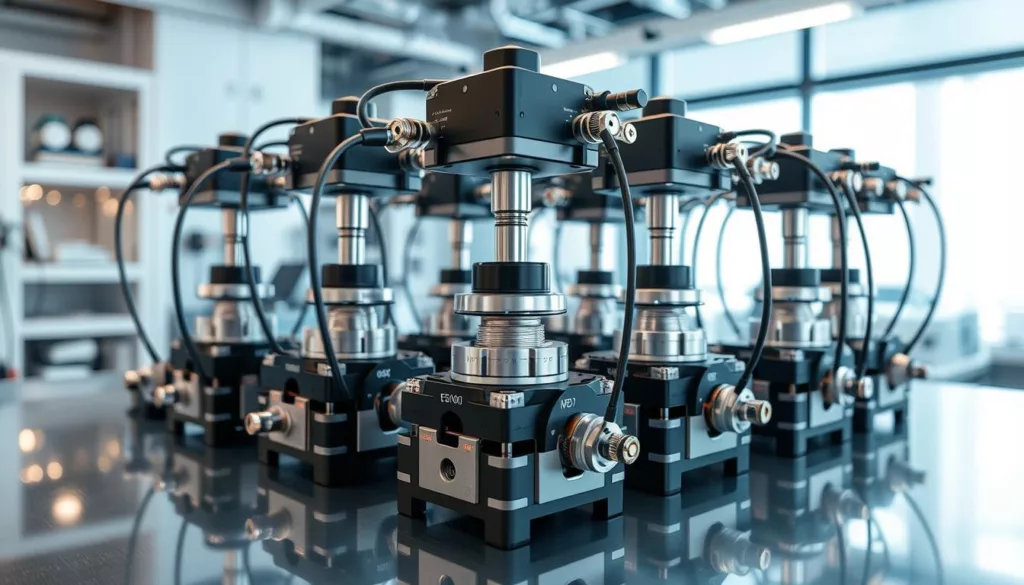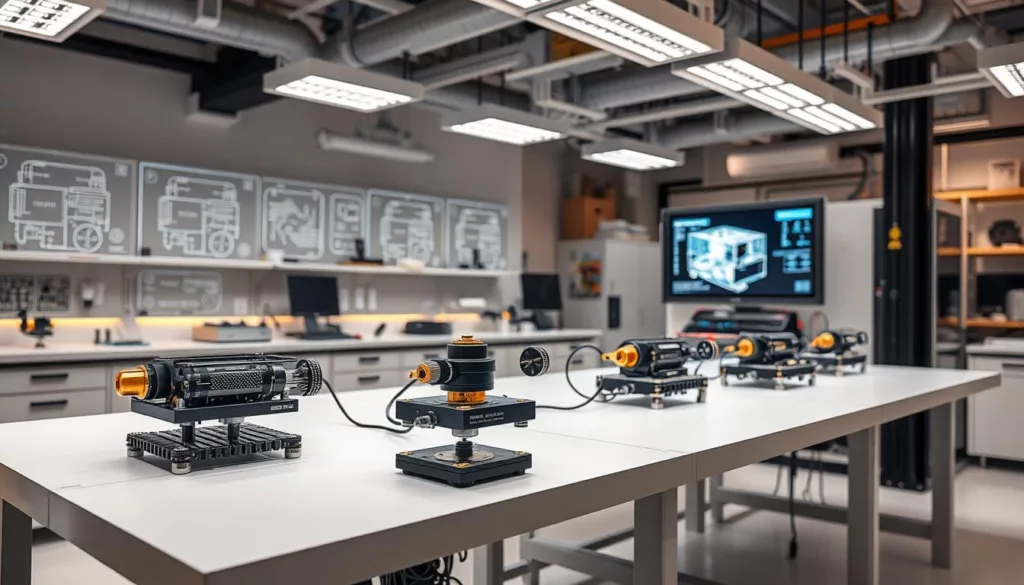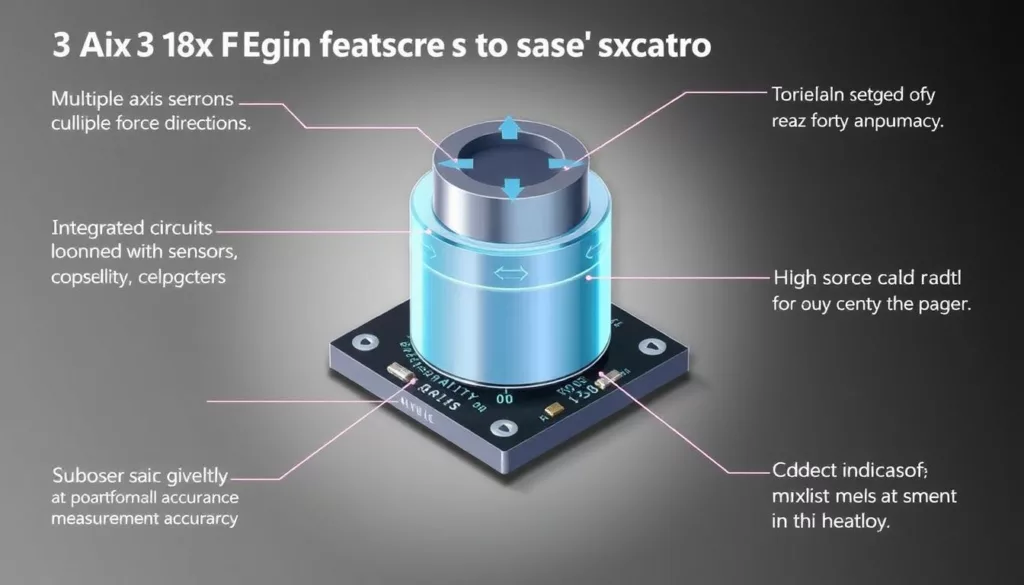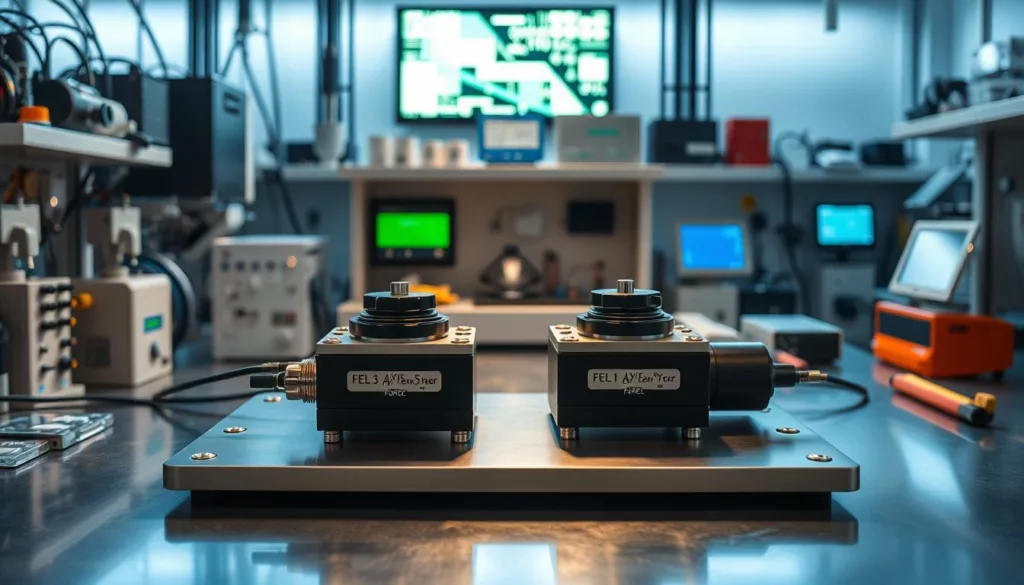In today’s world, knowing about 3 Axis Force Sensors is key for those in tech and engineering. This part looks at the top makers of 3 axis force sensors. We focus on the best ones who go beyond what’s expected.
Companies like XJCSENSOR lead the way as top producers. They set high standards in quality, precision, and reliability. They also keep up with the changing needs of the industry. By looking at these top makers, we learn a lot about their role in improving sensor technology.
Key Takeaways
- Industry leaders in 3 Axis Force Sensors show high precision and quality.
- Knowing what manufacturers offer helps make better choices.
- Innovation is vital in the competitive world of sensor making.
- XJCSENSOR shows how 3 Axis Force Sensor tech is advancing.
- Reliability and durability are important when picking the best makers.
Introduction to 3 Axis Force Sensors
3 Axis Force Sensors are key in force measurement technology. They measure forces along three axes: X, Y, and Z. These devices are vital in many industries, helping to analyze forces in different directions. This makes product development better and systems more efficient.
These sensors can measure forces in multiple directions at once. This is very useful in robotics, aerospace, car testing, and materials research. Knowing how they work helps us see their value in improving system performance.
Looking at the top makers of 3 axis force sensors, we see their unique features and technology. This shows how they set industry standards. Choosing the right sensors is key for accurate measurements and reliable data in important tasks.
Using advanced force measurement technology helps industries work better and innovate more. This leads to big improvements and advancements.
What are 3 Axis Force Sensors?
3 Axis Force Sensors are key in today’s sensor technology. They measure forces in three directions. This helps in many areas, like robotics and aerospace.
These sensors use advanced tech, like strain gauges and piezoelectric sensors. Strain gauges track how materials bend under force. Piezoelectric sensors turn this bending into electrical signals. This combo makes these sensors very accurate.
One big plus of multi-axis sensors is they give more info than single-axis ones. Single-axis sensors can’t handle all force types. But, 3 Axis Force Sensors measure force strength and direction. This is key for precise control and feedback.
The table below shows how single-axis sensors differ from multi-axis ones:
| Feature | Single-Axis Sensors | 3 Axis Force Sensors |
|---|---|---|
| Measurement Dimensions | 1 | 3 |
| Complexity of Data | Limited | Comprehensive |
| Applications | Basic Force Measurement | Robotics, Aerospace, Medical Devices |
| Accuracy | Medium | High |
Top makers in the field know how vital these sensors are. The best 3 Axis Force Sensor makers keep pushing the tech forward. They aim to make measurements more reliable and precise in many fields.
Applications of 3 Axis Force Sensors
3 axis force sensors are key in many industries. They measure force in three directions. This makes them useful in many areas.
In the car world, they’re used a lot. They help check if cars are safe and work well. This is during crash tests and when checking how cars perform.
In factories, they help robots and machines work better. They give exact measurements. This helps machines run smoothly and efficiently.
- Aerospace: Used in testing components for durability under various force conditions.
- Healthcare: Applied in prosthetics and medical devices, ensuring proper functionality.
- Consumer Electronics: Implemented in quality assurance processes to validate product resistance to forces during usage.
These sensors are getting more important. They help make products better and safer. They’re used in many fields, showing their value.
Top manufacturers of 3 Axis Force Sensors
Several key players dominate the 3 axis force sensor market. They lead with their innovations and strong presence. Their work has greatly shaped the competitive field.
Overview of Leading Players
XJCSENSOR is a top name for its advanced tech and focus on quality. Other leaders are known for their research and new features. They stand out by quickly meeting market needs and creating custom solutions.
Market Share Analysis
Market share data shows who’s leading in the 3 axis force sensor market. Some companies have grown by forming partnerships and diversifying their products. Here’s a table with the estimated market shares of the top players:
| Manufacturer | Estimated Market Share (%) | Key Strengths |
|---|---|---|
| XJCSENSOR | 25 | Innovative technologies, strong customer support |
| Honeywell | 15 | Established brand, extensive product range |
| Tekscan | 10 | Specialized solutions, research-driven |
| Futek | 10 | High precision, customizable options |
| ATI Industrial Automation | 8 | Robust design, reliability |
| Others | 22 | Varied strengths across niche markets |
Criteria for Selecting Top Manufacturers
Choosing the right manufacturer for 3 Axis Force Sensors is key. Look for quality certifications, as they show a commitment to standards and reliability. Also, check the manufacturer’s tech capabilities, as they can improve performance and accuracy.
Having a wide range of products is a plus. It means you can find what you need for different applications. Good customer support is also important. It can make a big difference in how happy you are with your purchase.
Here are some key factors to consider when choosing a manufacturer:
- Quality certifications and compliance
- Technological innovations
- Range of products offered
- Customer feedback and testimonials
- Delivery timelines and reliability metrics
By focusing on these points, you can make a smart choice. Knowing what to look for helps you pick the best. This includes manufacturers like XJCSENSOR, known for their precision and dedication to improvement.
| Criteria | Description |
|---|---|
| Quality Certifications | Indicates adherence to industry standards |
| Technological Capabilities | Advanced features enhance sensor performance |
| Product Range | Diverse options for various applications |
| Customer Support | Access to technical assistance and service |
| Reliability Metrics | Consistent performance and delivery timelines |
Key Features of Quality 3 Axis Force Sensors
Quality 3 axis force sensors have key features that meet tough industrial needs. Knowing these features helps pick the best sensors for top performance and efficiency.
Precision and Accuracy
Precision and accuracy are key in sensor tech. Advanced 3 axis force sensors give accurate measurements in multiple axes. This helps in reliable force checks, boosting performance metrics in fields like robotics and material testing.
High-quality making ensures little error, making them more effective.
Durability and Reliability
Durability is key for 3 axis force sensors, in tough environments. Quality making uses strong materials and methods to last long. This means sensors work well over time, cutting down on downtime and costs.
By focusing on quality manufacturing and new tech, makers make sensors ready for tough tasks and give vital data for bettering things.
| Feature | Importance |
|---|---|
| Precision | Ensures accurate measurements for reliable performance |
| Durability | Allows sensors to withstand challenging environments |
| Reliability | Minimizes downtime and improves operational efficiency |
| Quality Manufacturing | Results in high-performance and consistent output |
Top 3 Axis Force Sensor Brands in the Market
In the world of 3 axis force sensors, some brands really stand out. They are known for their new ideas and focus on quality. These top brands are always pushing the tech forward to meet the needs of many industries.
We’ve made a list of the best 3 axis force sensor makers. We looked at their reputation, unique tech, and what customers say. Brands like XJCSENSOR are known for being reliable and giving top-notch sensor solutions.
- XJCSENSOR: Famous for its leading-edge tech and wide range of products, this brand is a big player in the market.
- Kistler: Known for accurate measurements, Kistler uses deep engineering skills to boost performance.
- ATI Industrial Automation: This maker focuses on advanced sensing tech, giving full solutions for many uses.
These brands are known for great customer support and always bringing new ideas. Success stories show how these sensors help users in their work. By looking at each brand’s strengths, you can make a smart choice for your 3 axis force sensor needs.
Leading 3 Axis Force Sensor Producers in the USA
The market for 3 Axis Force Sensors has several top players. These US makers focus on innovation to meet various industry needs. They develop advanced tech that boosts performance and efficiency in many areas.
Innovative Technologies
US manufacturers invest a lot in research and development. They aim to create sensors that are very accurate and last long. Some key technologies include:
- High-resolution measurement: For applications that need high precision.
- Customized solutions: Products made to fit specific needs.
- Robust construction: Sensors that can handle tough environments.
These innovations meet current needs and open doors for new uses in robotics and automation. XJCSENSOR is a top name for its focus on precision and reliability in force measurement.
Customer Support and Services
Top producers stand out for their customer service. They offer full support from start to finish, including:
- Technical assistance: Help with choosing and using products.
- Warranty and repair services: Fast fixes for any problems.
- Continuous feedback loops: Working with clients to improve products.
US leaders in 3 axis force sensors focus on working closely with customers. This approach builds trust and loyalty. Their commitment to custom solutions and support makes them great partners for buyers.
Reputable 3 Axis Force Sensor Manufacturers to Consider
When looking for 3 axis force sensors, picking a reliable manufacturer is key. You want sensors that work well and last long. A good manufacturer has certifications, a big client list, and keeps innovating.
Here are some top brands to look at:
- Tensor Technologies – They lead in technology and offer many sensors. Perfect for precise needs.
- Force Measurement Solutions – They have a wide range of sensors known for being accurate and tough.
- Dynamic Sensor Systems – This company uses the latest tech. They set high standards for quality and new ideas.
- Precision Sensors, Inc. – They focus on what clients need. They’re great for custom sensor solutions.
Using industry tips can help you pick the best for your project. Choosing a well-known 3 axis force sensor maker can lead to better results.
Comparative Analysis of Different Manufacturers
We look closely at 3 Axis Force Sensors from various makers. We check many important things like what they offer, their tech, prices, and how happy their customers are. These things help us see how each brand stacks up.
We give you a detailed look at top manufacturers in the table below. It shows what makes each brand stand out.
| Manufacturer | Product Range | Technology | Price Range | Customer Reviews |
|---|---|---|---|---|
| Tekscan | FlexiForce Sensors | Thin-film technology | $100 – $500 | Excellent |
| Honeywell | Force Sensors | Micro-optical sensors | $200 – $700 | Very Good |
| Futek | Load Cells | Strain gauge technology | $150 – $800 | Good |
This comparison helps us see how brands compete in the market. We look at their tech and what customers say. This helps us choose the right one for our needs.
Recent Innovations in 3 Axis Force Sensors
Recent advancements in force sensors have been impressive, with a big leap in 3 Axis Force Sensors. These updates make sensors more useful and adaptable for many industries. The addition of smart tech like IoT lets us monitor and analyze data in real-time, boosting efficiency.
Emerging Technologies and Trends
The world of 3 Axis Force Sensors is changing fast, thanks to new tech and trends. One big change is making sensors smaller but more powerful. This meets the need for smaller, more efficient tools in places like factories and robotics.
Another trend is using new materials to make sensors last longer and work better in different conditions. This means sensors can handle more and last longer, which is great for keeping things running smoothly.
Also, adding artificial intelligence to sensors lets us predict when they might need fixing. This helps us fix things before they break, saving time and keeping things running smoothly. Keeping up with these new advancements is key for anyone working on projects.
| Innovation | Description | Impact |
|---|---|---|
| IoT Connectivity | Real-time data collection and analysis through internet integration | Increased efficiency and remote monitoring |
| Miniaturization | Development of smaller, more efficient sensor units | Enhanced applicability in tight spaces |
| New Materials | Implementation of advanced materials for improved durability | Longer sensor lifespan and reliability |
| AI Integration | Use of AI for predictive maintenance and analysis | Minimized downtime and optimized asset management |
Conclusion
Exploring top 3 Axis Force Sensor makers has given us a deep look into this important field. We’ve seen who leads in reliability and innovation. This summary shows both well-known and new players that are changing the force sensor world.
Choosing the right sensor is key. We must think about precision, durability, and new tech. By focusing on these, we make smart choices that meet our needs. Our findings stress how important these factors are for top sensor solutions.
The future of force sensors looks bright with ongoing innovation and new tech adoption. As the field grows, so will the sensors’ abilities and uses. This opens up new chances for industries that need precise force measurements. Keeping up with these changes helps us and our teams use the latest sensor tech to its fullest.





